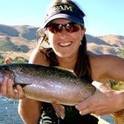
Presentation
Antiparasitic Properties of Plant Secondary Metabolites Extracted from Sagebrush (Artemisia spp.)
Idaho Conference on Undergraduate Research
Disciplines
Abstract
Herbivores may help us discover therapeutic natural products by observing which plants they consume when they are infected with diseases. Greater Sage-grouse (Centrocercus urophasianus) host a tapeworm (Raillietina centroceri) common to birds and forage selectively on sagebrush (Artemisia spp.), a plant that has diverse chemicals with cytotoxic properties. We hypothesized selection of sagebrush by sage-grouse with specific concentrations of chemicals can reduce parasite loads. Preliminary data show that parasite loads of sage-grouse are lower in winter when sagebrush represents a higher diet proportion than in fall. We tested our hypothesis using the Egg Hatch Assays to test the antiparasitic activity of two monoterpenes (cineole and camphor) and sagebrush extracts that were avoided or selected by sage-grouse during winter. We predicted individual compounds from the selected sagebrush would inhibit parasite eggs from hatching. This study will provide evidence that sagebrush chemicals can be exploited by sage-grouse to lower parasite loads. Results will be used to identify and isolate sagebrush chemicals that can be developed for antiparasitic uses for domestic animals and humans.
Citation Information
Brieana Goods, Marcella Fremgen, Jacqueline Peña and Jennifer Forbey. "Antiparasitic Properties of Plant Secondary Metabolites Extracted from Sagebrush (Artemisia spp.)" Available at: http://works.bepress.com/jennifer_forbey/47/
